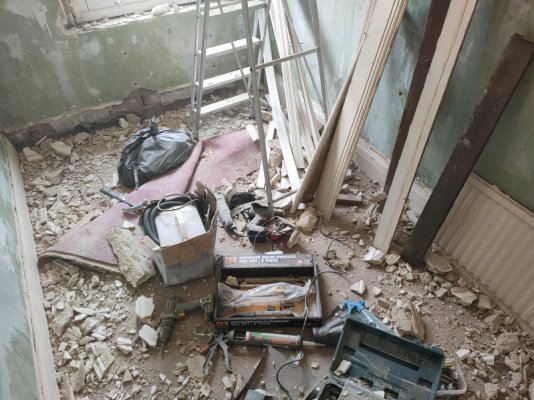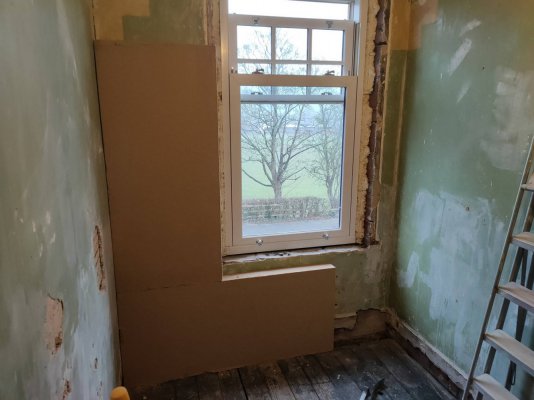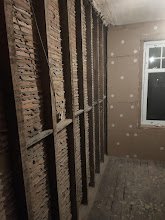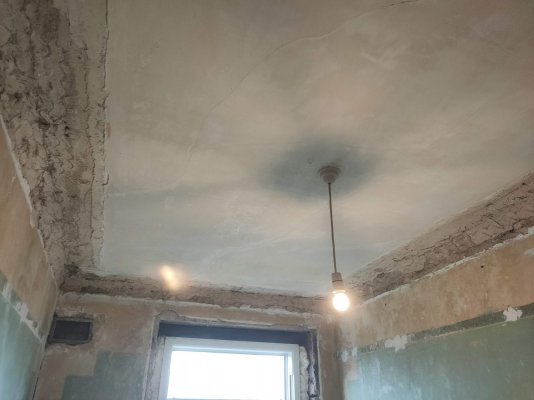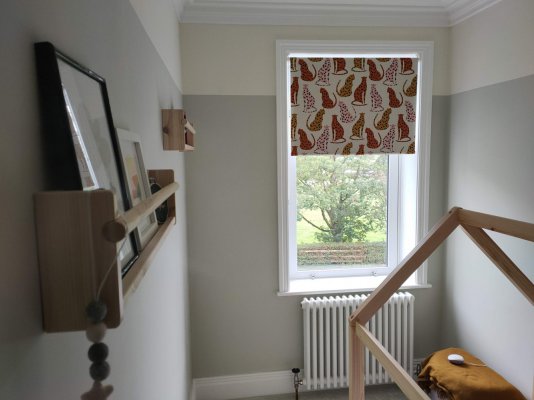Hello all,
Discovered this forum whilst researching products for renovations in our house, hopefully my question is specific enough to warrant a new thread! First a bit of background:
We've recently purchased an Edwardian (sand?) stone fronted Mid Terrace in Yorkshire. It's had the usual 'improvements' along the way including but not limited to polystyrene ceiling tiles, 70's stone flagged gas fire, and internal cement rendering by the damp man, but we believe the bones are good and with a bit of work can get it back looking it's best. We've started small, and are focusing efforts on what will be our daughter's first bedroom.
I've spent a few evenings steaming off the layers of wallpaper to reveal what I believe are the original lime plastered walls (see photo's attached). They don't look great but most of the walls are sound with just a few rough spots. The party wall is brick with around 15mm of plaster, comprised of approximately 12mm of coarse sandy coat, followed by 2-3mm of a smoother whiter coat. The internal wall looks to be stud with traditional lath and plaster with a coarse hairy base layer and smooth outer coat. The central portion of the ceiling seems to have been skimmed later, probably in gypsum?
The plan is to insulate internally the external wall with a longer term view of repeating the process room by room for all external facing walls. The external walls are approximately 400mm deep from external sill to internal surface and are either solid stone or a mix of stone and brick.
Having ruled out PIR, due to risks of interstitial condensation and a general aversion to petrochemical derived products, wood fibre iwi is the preferred choice. My questions is how deep do we go? I've read some research papers suggesting even 20mm will make a difference (as long as the reveals are also done) but there are diminishing returns going above 100mm. However much goes on will mean removing/damaging the only nice thing left in the room. The lovely coving is pretty deep; about 10cm from ceiling to wall extending 22cm from the wall into the ceiling. Parts will have to be removed to get the insulation to cover the wall entirely.
Some manufacturers also recommend extending the insulation into the party wall to eliminate colds spots but I'm less keen on hacking back solid plaster or having a really obvious bulge in the wall unless it can be chamfered.
If you're still reading, the TLDR for all this is how thick should I go with IWI (assuming coving will get damaged regardless of thickness) and what combination of products would you recommend to fix the holes in the plaster. Presumably a lime putty base layer and a finer mix to finish. I'm hoping to stabilise the blown bits of plaster with some form of adhesive, again would appreciate any products you could recommend.
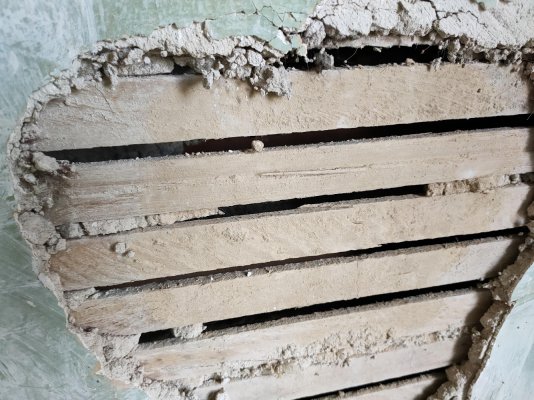
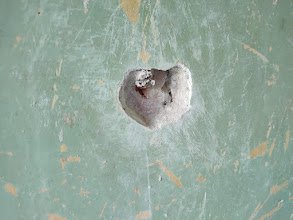
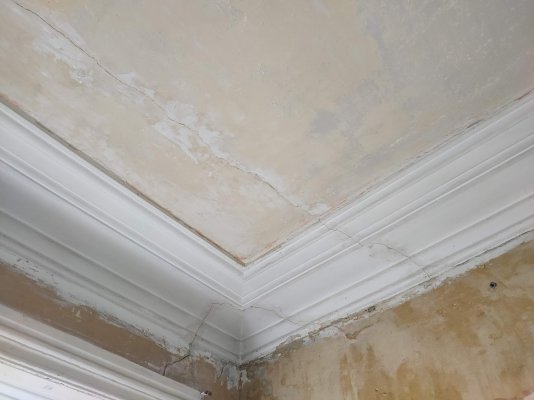
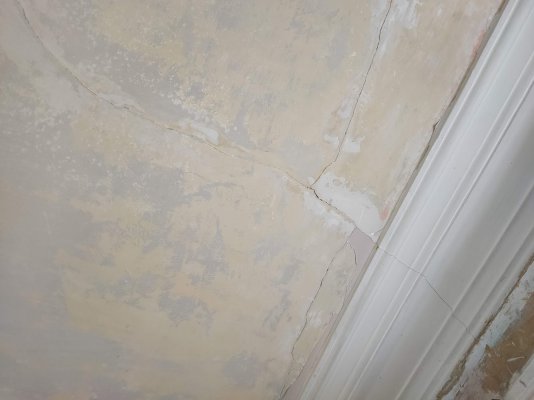
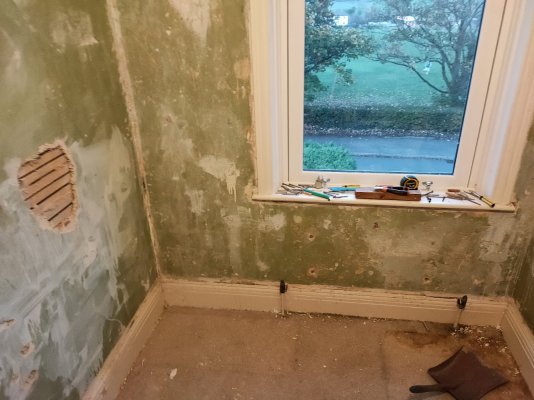
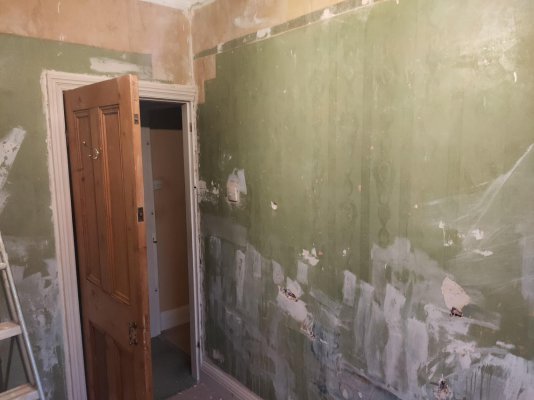
Discovered this forum whilst researching products for renovations in our house, hopefully my question is specific enough to warrant a new thread! First a bit of background:
We've recently purchased an Edwardian (sand?) stone fronted Mid Terrace in Yorkshire. It's had the usual 'improvements' along the way including but not limited to polystyrene ceiling tiles, 70's stone flagged gas fire, and internal cement rendering by the damp man, but we believe the bones are good and with a bit of work can get it back looking it's best. We've started small, and are focusing efforts on what will be our daughter's first bedroom.
I've spent a few evenings steaming off the layers of wallpaper to reveal what I believe are the original lime plastered walls (see photo's attached). They don't look great but most of the walls are sound with just a few rough spots. The party wall is brick with around 15mm of plaster, comprised of approximately 12mm of coarse sandy coat, followed by 2-3mm of a smoother whiter coat. The internal wall looks to be stud with traditional lath and plaster with a coarse hairy base layer and smooth outer coat. The central portion of the ceiling seems to have been skimmed later, probably in gypsum?
The plan is to insulate internally the external wall with a longer term view of repeating the process room by room for all external facing walls. The external walls are approximately 400mm deep from external sill to internal surface and are either solid stone or a mix of stone and brick.
Having ruled out PIR, due to risks of interstitial condensation and a general aversion to petrochemical derived products, wood fibre iwi is the preferred choice. My questions is how deep do we go? I've read some research papers suggesting even 20mm will make a difference (as long as the reveals are also done) but there are diminishing returns going above 100mm. However much goes on will mean removing/damaging the only nice thing left in the room. The lovely coving is pretty deep; about 10cm from ceiling to wall extending 22cm from the wall into the ceiling. Parts will have to be removed to get the insulation to cover the wall entirely.
Some manufacturers also recommend extending the insulation into the party wall to eliminate colds spots but I'm less keen on hacking back solid plaster or having a really obvious bulge in the wall unless it can be chamfered.
If you're still reading, the TLDR for all this is how thick should I go with IWI (assuming coving will get damaged regardless of thickness) and what combination of products would you recommend to fix the holes in the plaster. Presumably a lime putty base layer and a finer mix to finish. I'm hoping to stabilise the blown bits of plaster with some form of adhesive, again would appreciate any products you could recommend.










